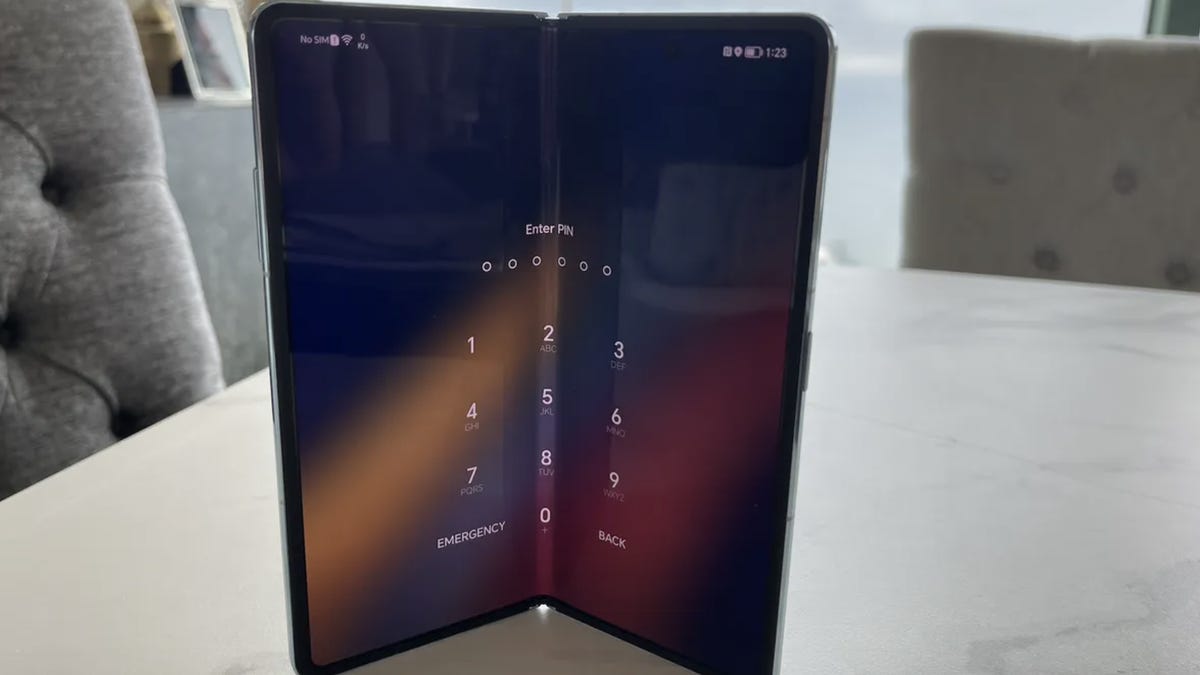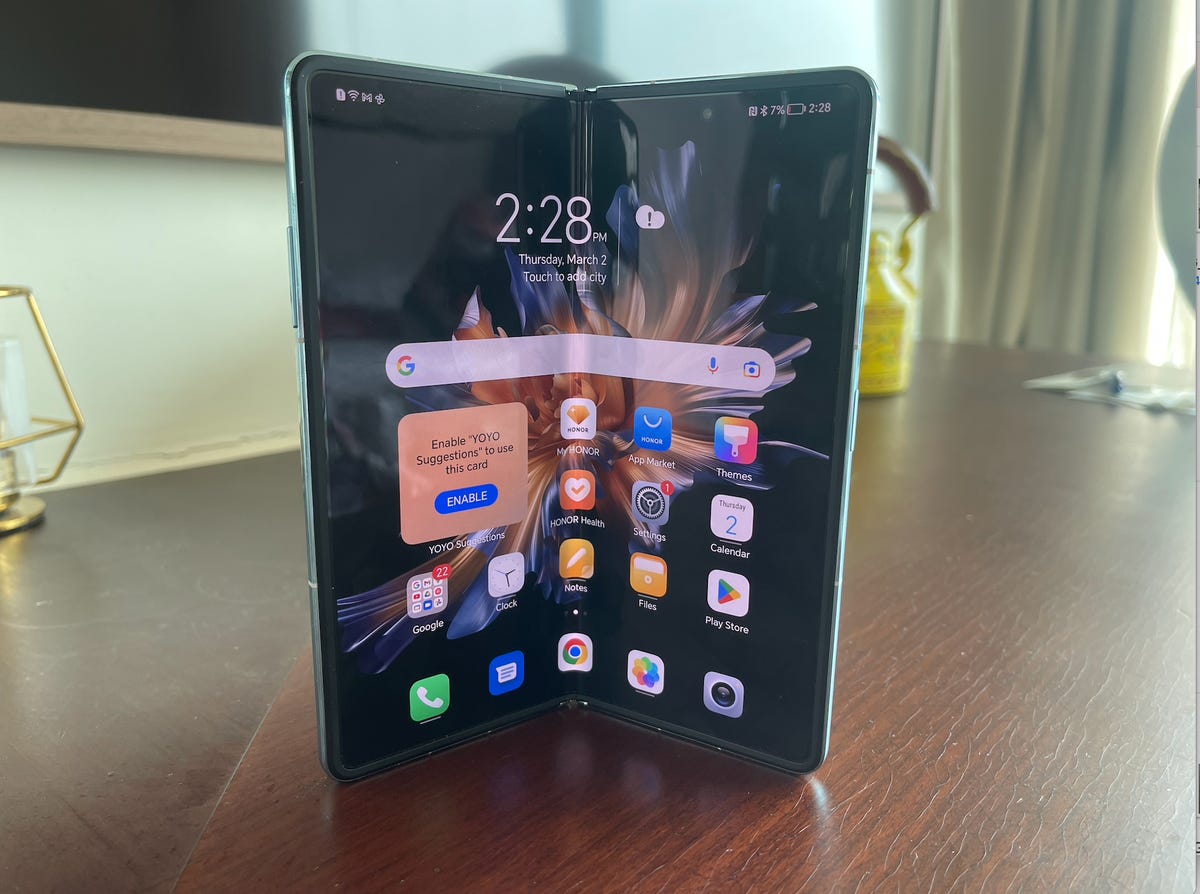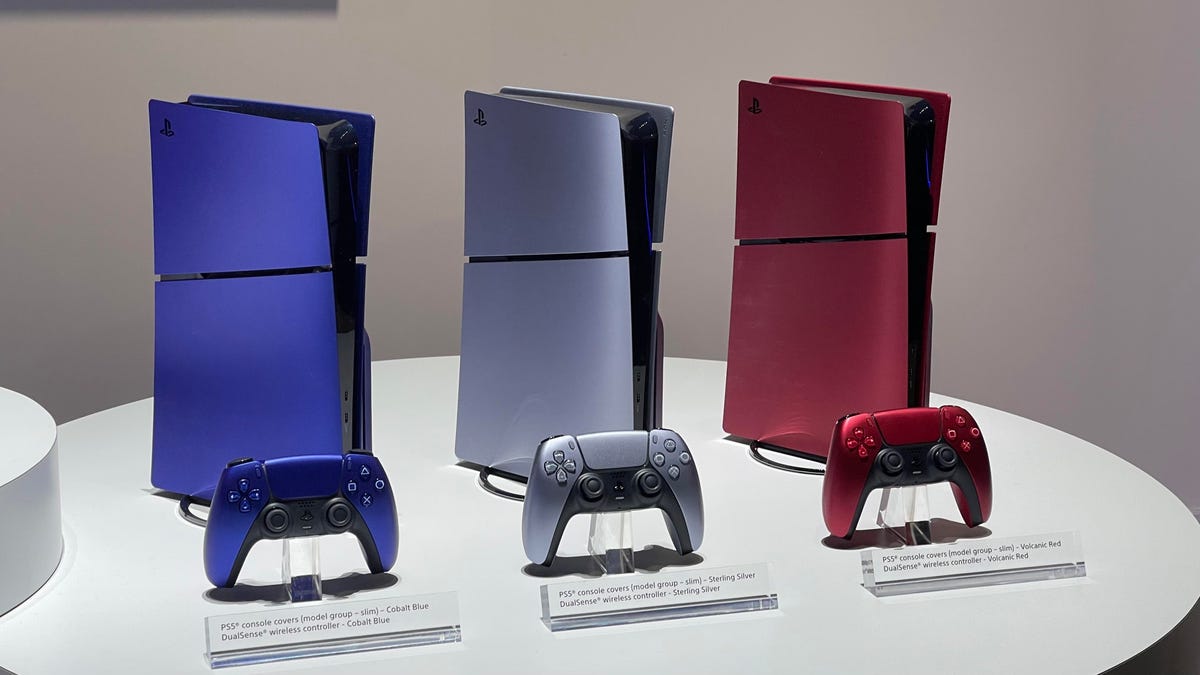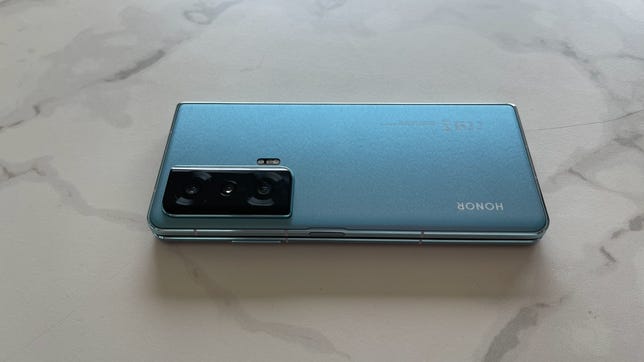Technologies
Honor Magic Vs Review: An Impressive First Try That Almost Rivals Samsung
The Magic Vs foldable phone still needs to improve before it can surpass the Galaxy Z Fold series. But it’s a commendable start.

Samsung finally has a new rival in the foldable phone ring: The Magic Vs foldable from Honor, formerly owned by Huawei. Honor revealed in September that it would bring its Honor Vs to international markets after a China release. This week, it showed off its book-style foldable flagship designed for a global audience at the Mobile World Congress in Barcelona.
I had the chance to test the Honor Magic Vs a few days before its launch. I was impressed with the device’s slick hardware, which is lightweight but also allowed the two halves of the phone to fold flat against each other without a gap. The Galaxy Z Fold 4, its biggest rival, still has a wedge-shaped gap when closed even in its newest iteration.
Beyond the standout features, the Honor Magic Vs packs all the specs you’d expect from a 2023 flagship phone into a slick package. That includes a large battery (5,000 mAh), fast charging (66 watts), a powerful Snapdragon 8 Gen Plus 1 processor, and three years of OS upgrades as well as five years of security patches. The only knock I could give in terms of specs is that it lacks the newer Snapdragon 8 Gen 2 chip found in the Galaxy S23 line and OnePlus 11.
Like
- Lightweight for a foldable
- Fantastic battery life
- Fast charging
Don’t Like
- Software doesn’t take nearly enough advantage of the fold
- No official IP rating
- Crease could be less obvious
- Less software updates than Galaxy Z Fold 4
However, it’s not perfect. The crease is more visible and discernible to the touch than other book-style foldables I’ve tested, such as the Oppo Find N and the Huawei Mate XS 2. The phone also lacks wireless charging and an official IP rating for water- and dust-resistance. By comparison, the Galaxy Z Fold 4 has an IPX8 rating for water-resistance.
That said, the Magic Vs starting price undercuts the Galaxy Z Fold 4 by 200 euros, and you also get more storage for that lower price. The Magic Vs starts at 1,599 euros for 12GB RAM and 512GB storage. By comparison, the Galaxy Z Fold 4 starts at 1,799 euros for 12GB RAM and 256GB of storage. There are no current plans for a US release, although the company said a UK launch is expected in June.


Honor wants the Vs to be a first-class phone first, and a tablet second. The inner screen has a 90Hz display, while the cover screen has a 120Hz display.
Sareena Dayaram/CNETHonor Magic Vs outer display is the focus
The Magic Vs’ headline feature is its bendable display. Like the Galaxy Z Fold 4, it has a cover screen and an interior screen. The outer screen measures 6.45 inches diagonally, while the inner display is 7.9 inches. I found both crisp, responsive and bright, and each screen also folds into the other with no discernible gap.
Unlike Samsung, Honor chose to equip the cover screen of its book-style foldable with superior specs. For example, it has better brightness (1,200 nits vs. 800 nits) and a higher refresh rate (120Hz vs. the inner screen’s 90Hz). For reference, the Magic Vs’ inner screen is a step below the 120Hz capability of the Galaxy Z Fold 4.
Considering this is a foldable phone, I found Honor’s choice to be counterintuitive at first. However, it seems Honor wants this device to be a phone first, and a tablet second. I think this decision helped prolong the battery life of the Honor Magic Vs — which, by the way, was fantastic. (More on that below.)
Honor Magic Vs inner display has an obvious crease
Honor says the Magic Vs has a creaseless display, but that didn’t turn out to be true. You can see and feel the inner display’s crease from various angles. It was immediately noticeable as soon as I opened the phone. I didn’t have to search for it as I have with other foldable phones, such as the Oppo Find N or the Huawei Mate XS 2.
Despite the crease, watching movies and flipping through pictures is fun and immersive. While it didn’t bother me much, such a large crease may be a deal-breaker for some. But it’s a compromise that fans of foldables may just have to learn to live with for now. Samsung’s Galaxy Z Fold 4 still has a crease, though it’s less noticeable than in the past. But Huawei’s Mate XS 2, which has a wraparound-style foldable phone design with one screen, is basically creaseless.
Key to the folding nature of this phone is the hinge. The company said the hinge is crafted with an aerospace grade polymeric material and has fewer components in its supporting structure (just four compared to 94). This helps make the hinge lighter and potentially more durable. Honor claims the hinge can withstand up to 400,000 folds, which means you can expect maybe 10 years of use out of it if you assume 100 folds per day. CNET hasn’t been able to independently verify that claim.
Honor Magic Vs camera
The Honor Magic Vs has three rear cameras, consisting of a 54-megapixel main camera, 50-megapixel ultrawide camera, and an 8-megapixel telephoto camera capable of 3x optical zoom. There’s also a 16-megapixel selfie camera, which is one less front-facing camera than the pricier Galaxy Z Fold 4.
Overall, I was happy with photo clarity, dynamic range, shutter speed and the versatility of the camera. Whether I was in bright, dim or even dark lighting environments, the camera captured crisp, vibrant and accurate photos in a variety of lighting scenarios. That said, this isn’t the best camera. It doesn’t measure up to the iPhone 14 Pro Max for instance, which tends to offer better low light photography. But I guess that’s OK (sort of) since you’re really paying for that fancy display, not the camera module.


This photo was taken through a window. The Honor Vs managed to capture a color accurate image with solid dynamic range.
Sareena Dayaram/CNET

10x zoom example.
Sareena Dayaram/CNET

30x zoom example. This image is relatively lacking in image noise considering how far the camera was zoomed in.
Sareena Dayaram/CNET

This setting was a tricky one to capture since the indoor environment was dim and there was bright light pouring through the windows. Despite this challenge, the camera captured a sharp image with crisp details indoors. Notice the detailing on the wooden floor and the bar seats.
Sareena Dayaram/CNET

The camera does a good job capturing the environment inside the window as well as outside.
Sareena Dayaram/CNET

Notice the sharp detailing of the plate and the contrasts in this photo. It was taken indoors.
Sareena Dayaram/CNET

I took this photo in a moving taxi and think it did a good job capturing motion.
Sareena Dayaram/CNETHonor Magic Vs battery performance
With a 5,000-mAh battery, the Honor Magic Vs has the largest battery of any commercially sold foldable phone. Non-foldable phones, such as the Galaxy S22 Ultra and the Galaxy S23 Ultra, have the same battery capacity.
The Magic Vs made it through most days of testing on a single charge with medium use. I didn’t need to bother charging at the end of the day since I usually had more than 20% remaining. But I charged overnight anyway out of habit.
When I ran a battery endurance test where I watched YouTube videos, scrolled through my Instagram feed, played Genshin Impact and took a 5-minute WhatAapp video call on the cover screen. The battery went from 100% to 86% in those 45 minutes.
The Magic Vs comes with a bundled 66-watt charger, which Honor says will completely replenish a dead battery within 46 minutes. Based on my experience, that claim was true, which means the Magic Vs outshines the Galaxy Z Fold 4 in this department.
The Magic Vs runs on 2022’s Snapdragon 8 Plus Gen 1. In my short time with this phone, the device performed without a hitch whether it was powering multiple apps, running games, streaming YouTube videos or even just switching between apps.


The Magic Vs propped up in a laptop-like position.
Sareena Dayaram/CNETHonor Magic Vs software
The Magic Vs runs Android 13 and Honor’s MagicOS. I’m a fan of MagicOS’ split-screen multi-tasking system, which includes a slide-over menu that you trigger by swiping and holding from the sides. You can multitask with up to four applications, and there’s a split screen mode as well as floating windows. You can also move apps around and resize their windows.
It’s a shame the software doesn’t take enough advantage of the phone’s folding design. I would have loved to see something like Samsung’s Flex mode on the Magic Vs. Even though I could use the phone when it was half-folded and prop it up like a laptop, none of the apps I used, even native ones, that were tailored for that experience. The Galaxy Z Fold 4’s Flex Mode software capabilities let you use the screen when it’s folded at a 90-degree angle.
With the Magic Vs’ slender hardware, solid cameras, fabulous battery life and intuitive multitasking features, Honor has created a solid rival to the Galaxy Z Fold 4. But it’s still tough to recommend the Magic Vs over the Galaxy Z Fold 4 for several reasons: There’s no IP rating, the crease is more visible, its software doesn’t really take advantage of the folding screen and Honor provides fewer software updates than Samsung. Honor made a solid first effort overall, though, and I’m so glad Samsung has more competition.
For more details on how the Magic Vs and the Galaxy Z Fold 4 compare, take a look at CNET’s specs chart below.
Honor Magic Vs specs vs. Galaxy Z Fold 4
| Honor Magic Vs | Galaxy Z Fold 4 5G | |
|---|---|---|
| Display size, resolution, refresh rate | Internal: 7.9 inches, 90Hz (2,272×1,984 pixels) External: 6.45 inches, 120Hz (2,560×1,080 pixels) | Internal: 7.6 inches (2,176×1,812 pixels) External: 6.2 inches HD+ (2,316×904 pixels) |
| Pixel density | Internal: 381 ppi External: 431 ppi | TBC |
| Dimensions (Millimeters) | Folded: 160.3×72.6×12. 9 mm; Unfolded: 160.3×141.5×6.1 mm | Folded: 67.1×155.1×15.8 mm (Hinge) ~ 14.2mm (Sagging); Unfolded: 130.1×155.1×6.3 mm |
| Weight (Ounces, Grams) | 9.23 oz, 261g (orange); 9.42 oz, 267g (black & cyan) | 9.27 oz; 263g |
| Mobile software | Android 13 | Android 13 |
| Camera | 54-megapixel (main), 50-megapixel (ultrawide), 8-megapixel (telephoto with 3x optical zoom) | 50-megapixel (main), 12-megapixel (ultrawide), 10-megapixel (telephoto) |
| Front-facing camera | 16-megapixels | 4-megapixel (under display), 10-megapixel (front cover) |
| Video capture | 4K | 4K |
| Processor | Snapdragon 8 Gen Plus 1 | Snapdragon 8 Gen Plus 1 |
| Storage/RAM | 12GB + 512GB | 12GB +256GB/512GB/1TB |
| Expandable storage | None | None |
| Battery/Charger | 5,000 mAh | 4,400mAh |
| Fingerprint sensor | Side | Side |
| Connector | USB-C | USB-C |
| Headphone jack | None | None |
| Special features | Foldable phone, 3x optical zoom, 66-watt bundled fast-charger | Foldable phone, 30x optical, 30x space zoom, IPX8, 25-watt fast-charging (no in-box charger) |
| Price(USD) | $1,695 (coverted) | $1,800 (256 GB) |
| Price (GBP) | £1,420 (converted) | £1,649 (256GB) |
| Price (Euros) | 1,599 euros (12GB RAM + 512GB) | 1,799 euros (256GB) |
Technologies
Silksong, Long-Awaited Hollow Knight Spinoff, Gets Release Date: Sept. 4
Announced in 2019, Team Cherry’s follow-up is coming sooner than expected, and it’s on Game Pass on Day 1.

Hollow Knight: Silksong is the follow-up, announced back in 2019, to one of the most beloved indie games of the last decade. In a special announcement video on Thursday, Australian developer Team Cherry revealed that the wait is almost over.
Silksong will be released on Sept. 4, according to the new trailer. The almost two-minute video reveals some of the new enemies and bosses in the upcoming spinoff and ends with the surprise release date.
Originally, Silksong was going to be a DLC for Hollow Knight. However, numerous delays resulted in it being pushed back again and again. Glimpses of the game would show up here and there over the years, but it was this year that it received the most attention from Nintendo as part of its Switch 2 lineup, and from Microsoft, which confirmed it would be available on Xbox Game Pass.
Hollow Knight: Silksong will be available on PC, Switch, Switch 2, Xbox One, Xbox Series X and Series S, PS4 and PS5. It will be available on Day 1 for Xbox Game Pass subscribers.
Technologies
PS5 Prices Go Up Today. Here’s How Much and Why
You can expect to pay more for a new PlayStation, thanks to «a challenging economic environment.»

Sony will increase the prices of its PlayStation 5 consoles in the US, starting today. This follows the trend of console manufacturers such as Microsoft and Nintendo raising prices for their hardware in response to tariffs.
The PlayStation-maker posted about the price change Wednesday. The jump in price is $50 more than the current price for each model.
The new prices are:
- PlayStation 5: $500 to $550
- PlayStation 5 Digital Edition: $450 to $500
- PlayStation 5 Pro: $700 to $750
«Similar to many global businesses, we continue to navigate a challenging economic environment,» Sony said in a post about the price increase.
As of Thursday morning, retailers and Sony’s online store have yet to update the console prices. This jump in price also will likely affect recently released PS5 bundles such as the Astro Bot bundle and Fortnite Cobal bundle.
Sony says accessories have not been affected by the change and this cost hike only affects the US.
In May, Microsoft increased the price of the Xbox Series consoles and Nintendo hiked the original Switch console price and Switch 2 accessories this month.
While the companies didn’t point to the tariffs instituted by President Donald Trump as the reason for the hardware price jump, it would explain the trend in recent months.
Technologies
Google Thinks AI Can Make You a Better Photographer: I Dive Into the Pixel 10 Cameras
The camera specs for the Pixel 10 series reveal only a small part of what’s new for mobile photographers. I spoke with the head of the Pixel camera team to learn more.
If a company releases new phone models but doesn’t change the cameras, would anyone pay attention? Fortunately that’s not the case with Google’s new Pixel 10, Pixel 10 Pro and Pixel 10 Pro Fold phones, which make a few advancements in the hardware — hello, telephoto camera on the base-level Pixel for the first time — and also in the software that runs it all, with generative AI playing an even bigger role than it has before.
«This is the first year where not only are we able to achieve some image quality superlatives,» Isaac Reynolds, group product manager for the Pixel cameras, told CNET, «but we’re actually able to make you a better photographer, because generative AI and large models can do things and understand levels of context that no technology before could achieve.»
Modern smartphone cameras must be more than glass and sensors, because they have to compensate for the physical limitations of those same glass and sensors. You can’t expect a tiny phone camera to perform as well as a large glass lens on a traditional camera, and yet the photos coming out of the Pixel 10 models surpass their optical abilities. In a call that covered a lot of photographic ground, Reynolds shared with me details about new features as well as issues of how we can trust images when AI — in Google’s own tools, even — is so prevalent.
Pro Res Zoom adds generative AI to reach 100x
The new Pro Res Zoom feature is likely to get the most attention because it strives for something exceptionally difficult in smartphones: long-range zoom that isn’t a fuzzy mess of pixels.
You see this all the time: Someone on their phone spreads two fingers against the screen to make a distant object larger in the frame. Photographers die a little each time that happens because, by not sticking to the main zoom levels — 1x, 2x, 5x and so on — the person is relying on digital zoom; the camera app is making pixels larger and then using software to try to clean up the result. Digital zoom is certainly better than it once was, but each time it’s used, the person sacrifices image quality for more zoom in the moment.
Google’s Super Res Zoom feature, introduced with the Pixel 3, interpolates and sharpens the image up to 30x zoom level on the Pixel 10 Pros (and up to 20x zoom on the Pixel 10 and Pixel 10 Pro Fold). The new Pro Res Zoom on the Pixel 10 Pro pushes way beyond that to 100x zoom — with a significant lift from AI.
Past 30x, Pro Res Zoom uses generative AI to refine and rebuild areas of the image based on the underlying pixels captured by the camera sensor. It’s similar to the technology that Magic Editor uses when you move an object to another area in the image, or type a prompt to add things that weren’t there in the first place. Only in this case, the Pixel Camera app creates a generative AI version of what you captured to give the image crisp lines and features. All the processing is performed on-device.
Reynolds explained that one of the factors driving the creation of Pro Res Zoom was the environments where people are taking photos. «They’re taking pictures in the same levels of low light — dinners did not get darker since we launched Night Sight,» he said. «But what is changing is how much people zoom, [and] because the tech is getting so much better, we took this opportunity to reset and refocus the program on incredible zoom quality.»
Pro Res Zoom works best on static scenes such as buildings, skylines, foliage and the like — things that don’t move. It won’t try to reconstruct faces or people, since generative AI can often make them stand out more as being artificially manipulated. The generated image is saved alongside the image captured by the camera sensor so you can choose which one looks best.
What about consistency and accuracy of the AI processing? Generative AI images are built out of pixel noise that is quickly refined based on the input driving them. Visual artifacts have often gone hand-in-six-fingered-hand with generated imagery.
But that’s a different kind of generative AI, says Reynolds. «When I think of Gen AI in this application, I think of something where the team has spent a couple of years getting it really tuned for exactly our use case, which is image enhancement, image to image.»
Initially, people inside Google were worried about artifacts, but the result is that «every image you see should be truly authentic to the real photo,» he said.
Auto Best Take
This new feature seems like a natural evolution — and by «natural,» I mean «processor speeds have improved enough to make it happen.» The Best Take feature was introduced with the Pixel 8, letting you capture several shots of a person or group of people, and have the phone merge them into one photo where everyone’s expressions look good. CNET’s Patrick Holland wrote in his review of the Pixel 8, «It’s the start of a path where our photography can be even more curated and polished, even if the photos we take don’t start out that way.»
That path has led to Auto Best Take, which does it automatically — and not just grabbing a handful of images to work with. Says Reynolds, «[It] can analyze… I think we’re up to 150 individual frames within just a few seconds, and pick the right five or six that are most likely to yield you the perfect photo. And then it runs Best Take.»
From the photographer’s point of view, the phone is doing all the work, though, as with Pro Res Zoom, you can also view the handful of shots that went into the final merged image if you’re not happy with the result. The shots are full-resolution and fully processed as if you’d snapped them individually.
«What’s interesting about this is you might actually find in your testing that Auto Best Take doesn’t trigger very often, and there’s a very particular reason for that,» said Reynolds. «Once the camera gets to look at 150 items, it’s probably going to find one where everybody was looking at the camera, because if there’s even one, it’ll pick it up.»
Improved Portrait mode and Real Tone
Another improvement enabled by the Pixel 10 Pro’s Tensor G5 processor is a new high-resolution Portrait mode. To take advantage of the wide camera’s 50-megapixel resolution, Reynolds said the Pixel team rebuilt the Portrait mode model so it creates a higher quality soft-background depth effect, particularly around a subject’s hair.
Real Tone, the technology for more accurately representing skin tones, is also incrementally better. As Reynolds explained, Real Tone has progressed from establishing color balances for people versus the other areas of a frame to individual color balances for each person in the image.
«That’s not just going to mean better consistency shot to shot, it means better consistency scene to scene,» he said, «because your color, your [skin] tone, won’t depend so strongly on the other things that happened in the image.»
He also mentioned that a core component of Real Tone has been the ability to scale up image quality testing methods and data collection in the process of bringing the feature’s algorithms to market.
«What standards are we setting for diversity and equity, inclusion across the entire feature set?» he said. «Real Tone is primarily a mission and a process.»
Instant View feature in the Pixel 10 Fold
One other significant photo hardware improvement has nothing to do with the cameras. On the Pixel 10 Pro Fold, the Pixel Camera app takes advantage of the large internal screen by showing the previous photo you captured on the left side of the display. Instead of straining to see details in a tiny thumbnail in the corner of the app, Instant View gives a full-size shot, which is especially helpful when you’re taking multiple photos of a person or subject.
Camera Coach
So far, these new Pixel 10 camera features are incorporated into the moment you capture a photo, but Reynolds also wants to use the phones’ cameras to encourage people to become better photographers. Camera Coach is an assistant that you can invoke when you’re stuck or looking for new ideas while photographing a scene.
It can look at the picture you’re trying to take and help you improve it using suggestions such as getting closer to a subject for better framing or moving the camera lower for a more dramatic angle. When you tap a Get Inspired button, the Pixel Camera app looks at the scene and makes suggestions.
«Whether you’re a beginner and you just need step-by-step instructions to learn how to do it,» said Reynolds, «or you’re someone like me who needs a little more push on the creativity when sometimes I’m busy or stressed, it helps me think creatively.»
CP2A content credentials
All of this AI being worked into the photographic process, from Pro Res Zoom to Auto Best Take, invariably brings up the unresolved question of whether the images we’re creating are genuine. And in a world that is now awash in AI-generated images that look real enough, people are naturally guarded about the provenance of digital images.
For Google, one answer is to label everything. Each image captured by the Pixel 10 cameras or touches Google Photos is tagged with C2PA Content Credentials (Coalition for Content Provenance and Authenticity), even if it’s untouched by AI. It’s the first smartphone with C2PA built in.
«We really wanted to make a big difference in transparency and credibility and teaching people what to expect from AI,» said Reynolds. «The reason we are so committed to saving this metadata in every Pixel camera picture is so people can start to be suspicious of pictures without any information.»
Marking images that have no AI editing is meant to instill trust in them. «The image with an AI label is less malicious than an image without one,» said Reynolds. «When you send a picture of someone, they can look at the C2PA in that picture. So we’re trying to build this whole network that customers can start to expect to have this information about where a photo came from.»
What’s new in the Pixel 10 camera hardware
Scanning the specs of the Pixel 10 cameras, listed below, you’d rightly notice that they match those found on last year’s Pixel 9 models, but a couple of details stand out.
For one, having a dedicated telephoto camera is no longer one of the features that separates the entry-level Pixel from the pro models. The Pixel 10 now has its own 10.8 megapixel, f/3.1 telephoto camera with optical image stabilization that offers a 5x optical zoom and up to 20x Super Res Zoom.
It’s not as good as the 48-megapixel f/2.8 telephoto camera used in the Pixel 10 Pro and Pixel 10 Pro XL (the same one used in the Pixel 9 Pros), but that’s not the point. You don’t need to give up extra zoom just to buy a more affordable phone.
Another difference you’ll encounter, particularly when recording video, is improved image stabilization. The optical image stabilization is upgraded in all three phones, but the stabilization in the Pixel 10 Pros is significantly improved. Although the sensor and lens share the same specs as the Pixel 9 Pro, the wide-angle camera in the Pixel 10 Pro models necessitated a new design to accommodate new OIS components inside the module enclosure. Google says it doubled the range of motion so the lens physically moves through a wider arc to compensate for motion. Alongside that, the stabilization software has been tuned to make it smoother.
Camera Specs for the Pixel 10 Lineup
| Pixel 10 | Pixel 10 Pro | Pixel 10 Pro XL | Pixel 10 Pro Fold | |
| Wide Camera | 48MP Quad PD, f/1.7, 1/2″ image sensor | 50MP Octa PD, f/1.68, 1/1.3″ image sensor | 50MP Octa PD, f/1.68, 1/1.3″ image sensor | 48MP Quad PD, f/1.7, 1/2″ image sensor |
| Ultra-wide Camera | 13MP Quad PD, f/2.2, 1/3.1″ image sensor | 48MP Quad PD with autofocus, f/1.7, 1/2.55″ image sensor | 48MP Quad PD with autofocus, f/1.7, 1/2.55″ image sensor | 10.5MP Dual PD with autofocus, f/2.2, 1/3.4″ image sensor |
| Telephoto Camera | 10.8MP Dual PD with optical image stabilization, f/3.1, 1/3.2″ sensor size, 5x optical zoom | 48MP Quad PD with optical image stabilization, f/2.8, 1/2.55″ image sensor, 5x optical zoom | 48MP Quad PD with optical image stabilization, f/2.8, 1/2.55″ image sensor, 5x optical zoom | 10.8MP Dual PD with optical image stabilization, f/3.1, 1/3.2″ sensor size, 5x optical zoom |
| Front camera | 10.5MP Dual PD with autofocus, f/2.2 | 42MP Dual PD with autofocus, f/2.2 | 42MP Dual PD with autofocus, f/2.2 | 10MP Dual PD, f/2.2 |
| Inner camera | n/a | n/a | n/a | 10MP Dual PD, f/2.2 |
-

 Technologies3 года ago
Technologies3 года agoTech Companies Need to Be Held Accountable for Security, Experts Say
-

 Technologies2 года ago
Technologies2 года agoBest Handheld Game Console in 2023
-

 Technologies2 года ago
Technologies2 года agoTighten Up Your VR Game With the Best Head Straps for Quest 2
-

 Technologies4 года ago
Technologies4 года agoVerum, Wickr and Threema: next generation secured messengers
-

 Technologies4 года ago
Technologies4 года agoGoogle to require vaccinations as Silicon Valley rethinks return-to-office policies
-

 Technologies4 года ago
Technologies4 года agoBlack Friday 2021: The best deals on TVs, headphones, kitchenware, and more
-

 Technologies4 года ago
Technologies4 года agoOlivia Harlan Dekker for Verum Messenger
-

 Technologies4 года ago
Technologies4 года agoiPhone 13 event: How to watch Apple’s big announcement tomorrow

